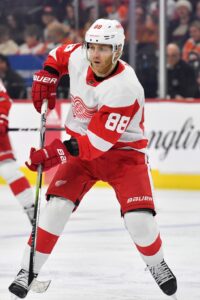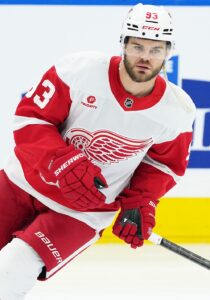Navigating the salary cap is one of the most important tasks for a front office. Teams that can avoid total cap chaos by walking the tightrope of inking players to deals that match their value (or compensate for future value without breaking the bank) remain successful. Those who don’t often see struggles and front office changes.
PHR will look at every NHL team and give a thorough look at their cap situation for the 2025-26 season. This will focus more on players who are regulars on the roster versus those who may find themselves shuttling between the AHL and NHL. All cap figures are courtesy of PuckPedia . We’re currently covering the Atlantic Division, next up are the Red Wings.
Detroit Red Wings
Current Cap Hit: $83,641,833 (below the $95.5MM Upper Limit)
Entry-Level Contracts
F Michael Brandsegg-Nygard
(three years, $942.5K)
D Simon Edvinsson
(one year, $894.1K)
F Emmitt Finnie
(three years, $821.7K)
F Marco Kasper
(two years, $886.7K)
D Axel Sandin Pellikka
(three years, $918.3K)
Potential Bonuses
Brandsegg-Nygard: $500K
Edvinsson: $850K
Kasper: $1MM
Sandin Pellikka: $500K
Total: $2.85MM
Considering the season he had overseas, it was a bit surprising to see Brandsegg-Nygard break camp with Detroit but tying for the league lead in preseason goals and points earned him a spot. Considering he’s just starting out, it’s too early to forecast another contract but if he wants a long-term second contract, he’ll need to be established as a regular top-six player by the time it expires. Finnie was another training camp surprise where his preseason efforts earned him a spot. He’s in the same boat as Brandsegg-Nygard when it comes to his next deal though.
That can’t quite be said for Kasper. His first full NHL season was a strong one where he was in the top six more often than not. If he stays on that trajectory, he’s someone who could plausibly bypass a bridge deal. In this market of escalating salaries, a deal might push into the $7.5MM territory even if he remains more of a second liner at that time. Meanwhile, a bridge pact would check in with a number likely starting with a four.
Sandin Pellikka is also in his first full year in North America and while many expected he’d at least start the season in AHL Grand Rapids, he also broke camp with the big club. If he has the type of impact they hope he will (as an offensive top-four defender), he’s someone that they might look to sign to a long-term deal coming off his entry-level pact. But again, it’s far too early to forecast, given that he’s only a handful of games into his NHL career.
Edvinsson is a different case. A full-time top-four player in his rookie year, he’s someone who appears to be living up to his lofty draft billing. GM Steve Yzerman doesn’t dole out a lot of long-term deals but this is a case where it wouldn’t be surprising to see him try to do so. They did this with another young blueliner recently who we’ll get to later but it wouldn’t be surprising to see them use that price tag as an internal ceiling for an Edvinsson extension.
Signed Through 2025-26, Non-Entry-Level
F Jonatan Berggren
($1.825MM, RFA)
D Jacob Bernard-Docker
($875K, RFA)
D Ben Chiarot
($4.75MM, UFA)
D Erik Gustafsson
($2MM, UFA)
D Travis Hamonic
($1MM, UFA)
D Justin Holl
($3.4MM, UFA)
F Patrick Kane
($3MM, UFA)
G Cam Talbot
($2.5MM, UFA)
F James van Riemsdyk
($1MM, UFA)
Potential Bonuses
Kane: $4MM
van Riemsdyk: $750K
Total: $4.75MM
 Once again, it took until the eve of free agency for Kane and the Red Wings to work a deal out. This one gave him a bit less in guaranteed money by $1MM but added $1.5MM in incentives, giving him a chance at beating his earnings from last season. He’ll earn $2.5MM of those after just 10 games and another $500K by the time he reaches 50 games so as long as he stays healthy, he’s a $6MM player this season. In this market, that’s not a bad price tag for a winger who is probably best served as a second-line winger at this point but can move up in a pinch. While he turns 37 next month, he could plausibly keep playing for another couple of seasons with this type of contractual structure.
Once again, it took until the eve of free agency for Kane and the Red Wings to work a deal out. This one gave him a bit less in guaranteed money by $1MM but added $1.5MM in incentives, giving him a chance at beating his earnings from last season. He’ll earn $2.5MM of those after just 10 games and another $500K by the time he reaches 50 games so as long as he stays healthy, he’s a $6MM player this season. In this market, that’s not a bad price tag for a winger who is probably best served as a second-line winger at this point but can move up in a pinch. While he turns 37 next month, he could plausibly keep playing for another couple of seasons with this type of contractual structure.
Berggren was largely a regular last season after spending most of his sophomore year in the minors but wasn’t able to match his rookie-season numbers, yielding this bridge deal this summer. He’ll need to establish himself a little higher on the depth chart or he risks becoming a non-tender candidate when he gains arbitration eligibility next summer. As for van Riemsdyk, he didn’t need a late-summer deal this time around after a decent showing in a depth role with Columbus. Notably, $500K of his bonuses are playoff-dependent while the other $250K kicks in at 50 GP. At this point in his career, he’s likely to remain around this price point on one-year deals.
Chiarot’s contract was a surprise three summers ago, both in terms of money and term. He remains a top-four blueliner for Detroit but is someone who is trending more toward being a fourth or fifth defender given that he’ll be 35 when his next contract begins. A two-year deal could still be doable but a drop down to a price tag starting with a three looks likely at this point. Holl has cleared waivers for the second straight year and is in Grand Rapids where his cap charge has dropped to $2.25MM. If he made half of what he makes now, there might have been a taker for him on waivers. Accordingly, despite teams passing on him for free now, there still could be enough of a market for him to land around $1.5MM on a one-year prove-it type of contract next summer.
Gustafsson had a so-so first season in Detroit as an offense-first defender, picking up 18 points in 60 games but also struggling defensively. He lost his roster spot and is now in the minors, carrying a reduced cap charge of $875K. He’s likely to land closer to half of his current cap charge unless he’s able to come back and be productive. Hamonic was a depth defender last season in Ottawa and has had a similar role this season. At 35 and with some heavy lifting in minutes in his prime, he’s unlikely to land much more than this if he gets a contract for next season. Bernard-Docker also spent most of last season in a depth role with the Senators and is merely looking to establish himself as a full-time player. He’s arbitration-eligible but unless he’s a regular, he’ll be a non-tender candidate, even if they want to keep him around since he entered the season with 144 games of NHL experience already.
Talbot was brought in via free agency in 2024 to help shore up the goaltending position. However, he was more of a platoon-level piece than a true starter, resulting in them attempting to shore up that spot this past summer. Still, this price tag for a serviceable backup at a minimum is pretty reasonable in this market. He’ll be heading into his age-39 year if he looks to play next season so his next contract, if there is one, should be a one-year pact around this price point.
Signed Through 2026-27
F Mason Appleton
($2.9MM, UFA)
F Andrew Copp
($5.625MM, UFA)
F Alex DeBrincat
($7.875MM, UFA)
G John Gibson
($6.4MM, UFA)
D Albert Johansson
($1.125MM, RFA)
F Elmer Soderblom
($1.125MM, RFA)
 While the idea of signing a medium-term deal has grown in popularity around the league lately while looking for a more favorable cap environment next time, DeBrincat was one of the first to do so after being acquired in 2023. It bought Detroit three extra years of control but allows DeBrincat to hit the open market at 29. A max-term contract should be achievable for him at that time and given his offensive consistency as a legitimate top-six winger who typically collects between 65 and 70 points most years, he should be in a good position to push past the $10MM mark. Detroit won’t be able to use an internal ceiling if they want to retain him.
While the idea of signing a medium-term deal has grown in popularity around the league lately while looking for a more favorable cap environment next time, DeBrincat was one of the first to do so after being acquired in 2023. It bought Detroit three extra years of control but allows DeBrincat to hit the open market at 29. A max-term contract should be achievable for him at that time and given his offensive consistency as a legitimate top-six winger who typically collects between 65 and 70 points most years, he should be in a good position to push past the $10MM mark. Detroit won’t be able to use an internal ceiling if they want to retain him.
Copp was brought in via free agency in 2022 on the heels of a career year offensively. He hasn’t been able to match that in Detroit although he brings enough other elements to the table to give them at least a reasonable return. Still, even in this inflated market, he’ll be hard-pressed to match this price tag if he remains in the 30-point range offensively. However, another multi-year deal should be doable at least.
Appleton had a quiet contract year in Winnipeg which limited his market this summer. However, if he can get back to the 30-point range where he was in 2023-24, he could push for something closer to the $4MM range on his next deal. Soderblom split the last two seasons between Detroit and AHL Grand Rapids, making a low-cost bridge deal this summer a guarantee. He’ll have arbitration rights two years from now and if he’s a regular in their bottom six, doubling this cost doesn’t seem unreasonable.
Johansson got his first taste of NHL action last season, seeing regular action on the third pairing. Given the inexperience, a bridge deal was the only play here as well. Like Soderblom, he’ll have arbitration rights next time out and assuming he remains a regular top-six piece, doubling this price tag (at a minimum) should be doable.
Gibson was much better in Anaheim last season after some tough years but with Lukas Dostal in place as the starter of the present and future, the Ducks opted to move him with Yzerman seeking another short-term upgrade. If he can get back to being a starting-caliber netminder, the Red Wings will do quite well with what’s left of this contract. However, if he remains more of a platoon piece, he’ll be a considerable overpayment, albeit one they can easily afford right now. He might be more in the $5MM range on his next deal, if not a bit lower.
